To know the wilderness is to follow its stories — the slow, unhurried rhythms, the familiar faces, and the sudden turns that remind us how little in nature can ever be predicted.
Among these, the stories of the Tanda Tula lions have long captured our guests’ imagination.
One aspect that our guests often comment on, when joining our team of experienced guides out on safari in the vast wilderness that forms part of the Greater Kruger, is how we are able to identify – and know so much about – the resident animals that call Tanda Tula home.
The reason is that we get to follow just enough of their lives to piece together their stories; stories that are mostly slow-burning and somewhat predictable, but just occasionally have explosive twists and turns that rewrite their futures. Watching their daily lives unfold is like tuning into a soap opera – the difference being, our animals’ stories are unscripted.

A tense moment between lions unfolds in a swirl of dust — a vivid reminder of the raw power and unpredictable dynamics that shape life in the Timbavati.
Those who have been following our blogs will know that lions have been front-and-centre of our game-viewing for some time. Having worked in the Timbavati for almost two decades, I have seen ebbs and flows in lion numbers over the years, but never have I seen such stability within the prides. Nor have I had as many lions to show our guests. Regular guests (and blog readers) of ours saw 58 different lions on one trip in 2023, and 53 lions on their next trip in 2024. That is a load of lions!
It has been wonderful having them around, but things are beginning to change. The stability that has been such a feature is now under threat, and for the first time in a long while we are having to speculate about what could potentially unfold over the coming months. So, instead of speculating over a cup of coffee with fellow guides in the early morning, I thought this would be a good opportunity to speculate out loud with you. Allow me to share what has been happening of late, and what could unfold going forward (bearing in mind that my predictions are almost always wrong 😁).

The Mayambula pride pauses for a morning drink, a rare sight that captures the strength and unity of this remarkable lion family.

The Giraffe pride moves purposefully through the Timbavati wilderness, a proud display of strength and family unity.
So why has it been so stable?
The stability of the lions in recent years has come from the dominant presence of the five Vuyela males. Brutes. They are the biggest lions in the Timbavati, and with numbers on their side, they have had the power to take over multiple prides. Their first steps to dominance came when they took over the Sark Breakaway Pride in 2021 and began siring cubs with them. Today, seven youngsters from those early efforts are still alive and with the pride. Three more youngsters were sired over the past 18 months.

Two Vuyela males watch over the Sark Breakaway Pride in the golden light of dawn — a moment of strength, protection, and pride in the Timbavati.
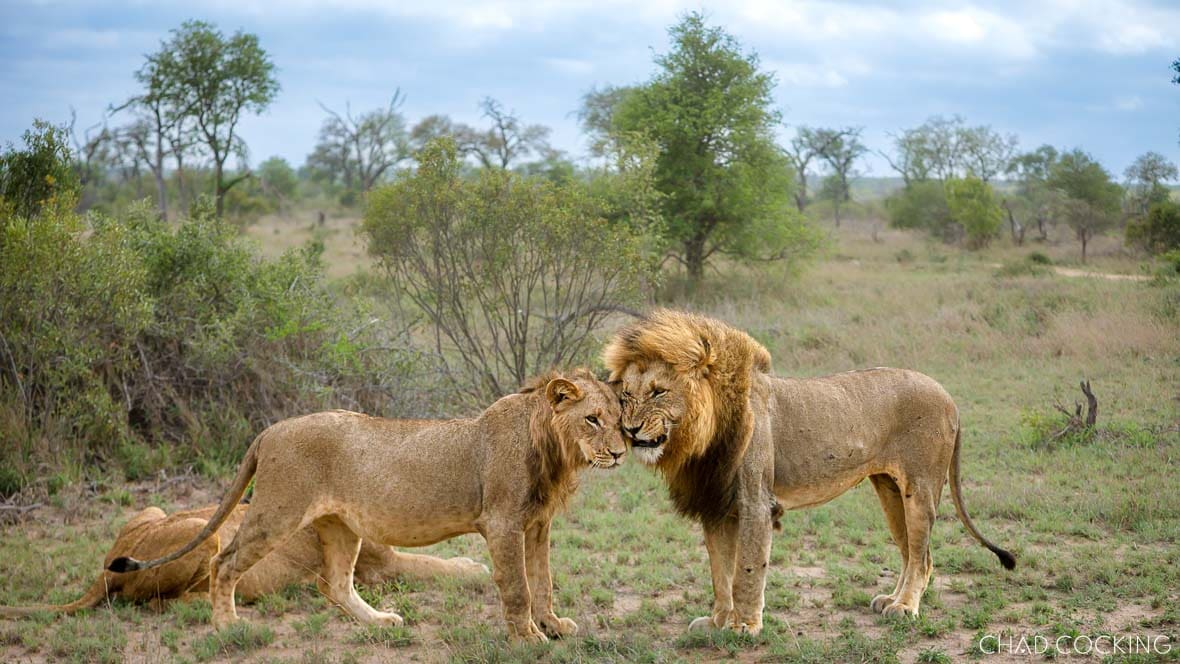
A tender yet powerful moment as the Vuyela male greets one of his sons — a quiet exchange that speaks to the strength and legacy of this lion lineage.
With mating opportunities drying up with the Sark Breakaways, the Vuyelas moved on to find the River Pride – a pride up for grabs after their previous dominant male fled in the face of new competition – and have been their dominant males since 2023, with six subadults sired by them still found within the pride.

A dominant Vuyela male mates with a River Pride female beside a quiet waterhole — the timeless cycle of life in the Timbavati.
Once again, with no mating opportunities, the five Vuyela males went in search of a new pride. They found it in the form of nine lionesses from the Mayambula Pride who had briefly fallen under the control of the Birmingham Breakaway males, but these males abandoned ship and headed far west as the Vuyela males showed up in Mayambula territory in late 2024.
Three prides in 20 000 hectares of territory – that requires a lot of work to protect, even for five brute males.

Current lion dynamics across the Timbavati, showing the ranges of the River Pride, Sark Breakaway Pride, Giraffe Pride, Mayambula Pride, and the dominant coalitions.
Biting off more than they could chew
It was at this point that the cracks started to show. As the months passed, even the lone Vuyela male that used to visit the Sark Breakaways abandoned his paternal responsibilities. In June he was with them briefly on a dead elephant, but that was the last time he – or any Vuyela male – was seen anywhere near the pride.
The River Pride has fared no better – the last time they were seen in the company of the Vuyela males was when a giraffe dropped dead in their territory, and the pride arrived a couple of days after the Vuyela males found the free meal. As soon as that was done, the males moved off and haven’t been seen with them since. At least the Vuyelas still occasionally patrol in River Pride territory – the same definitely cannot be said for the Sark Breakaway territory.
It was a matter of time
A year ago we would be woken by the roars of male lions around Tanda Tula on an almost nightly basis. Of late, those old Vuyela roars are distant, erratic and ineffective. It was only a matter of time before the absence of any sign of dominant males, combined with the scent of lionesses, drew in some competition. Now, new roars are coming from over the western horizon.
It was these roars that signalled change. In June, the two blonde, five-and-a-half-year-old male lions from the northern Klaserie made their first appearance. We knew nothing of who they were or where they came from. Step in the internet sleuths, and my trusted source for all things lion-related was soon divulging their life story to me.
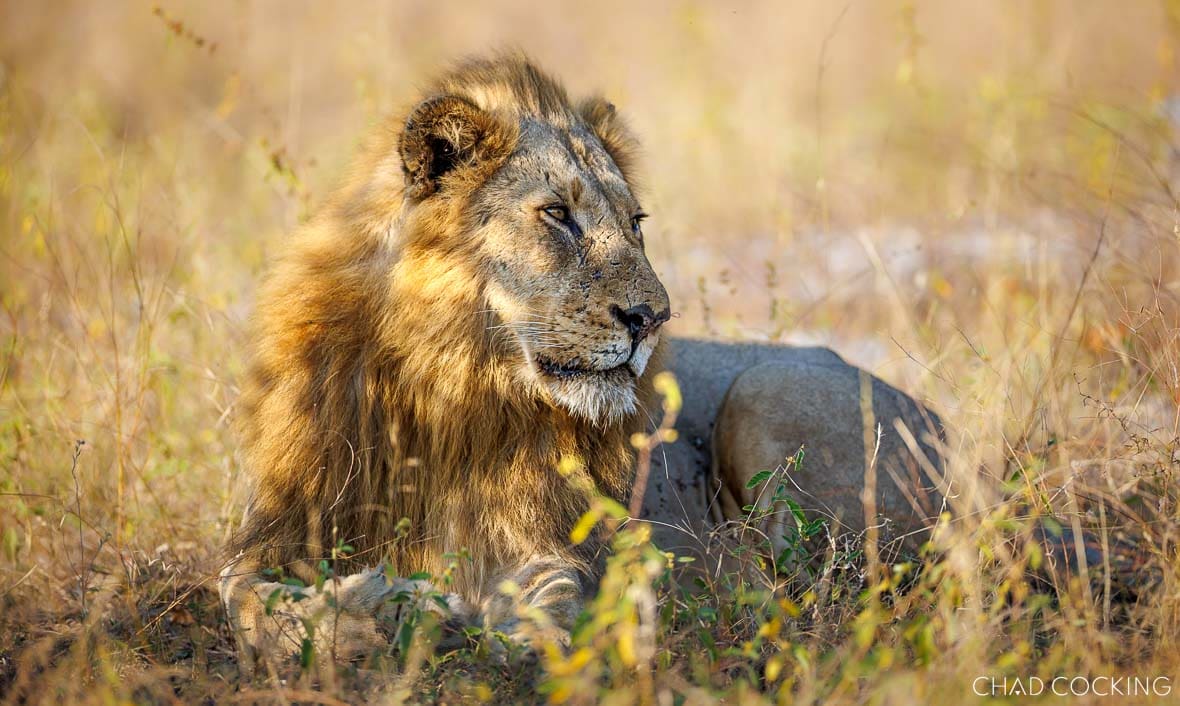
The Nkombo male, a rising force in the Timbavati, rests watchfully in the soft light of the afternoon.

A powerful portrait of the Nkombo male, his mane catching the light as he surveys his expanding territory.
Forming a seven-strong breakaway pride from the Klaserie River Pride, these two young males became part of a pride known as the Nkombo Pride. Their five younger male cousins soon left their natal Klaserie River Pride and moved into the northern Timbavati as the Ncila males. It wasn’t long after that the two Nkombo males made their first appearance in the Timbavati. At first we thought it would be a fleeting visit – surely the Vuyela males would hear their roars and come and put them in their place? But over the past two months, they have become increasingly active in the area with no response from the Vuyelas. The Nkombo males have also found what they were after; receptive lionesses.
Without any pride males, the younger females of the Sark Breakaway Pride have an instinctive desire to reproduce. It takes two to tango, so when the Nkombo males pitched up on the scene, they were quick to throw themselves at the new males, and we saw them mating in mid-September.
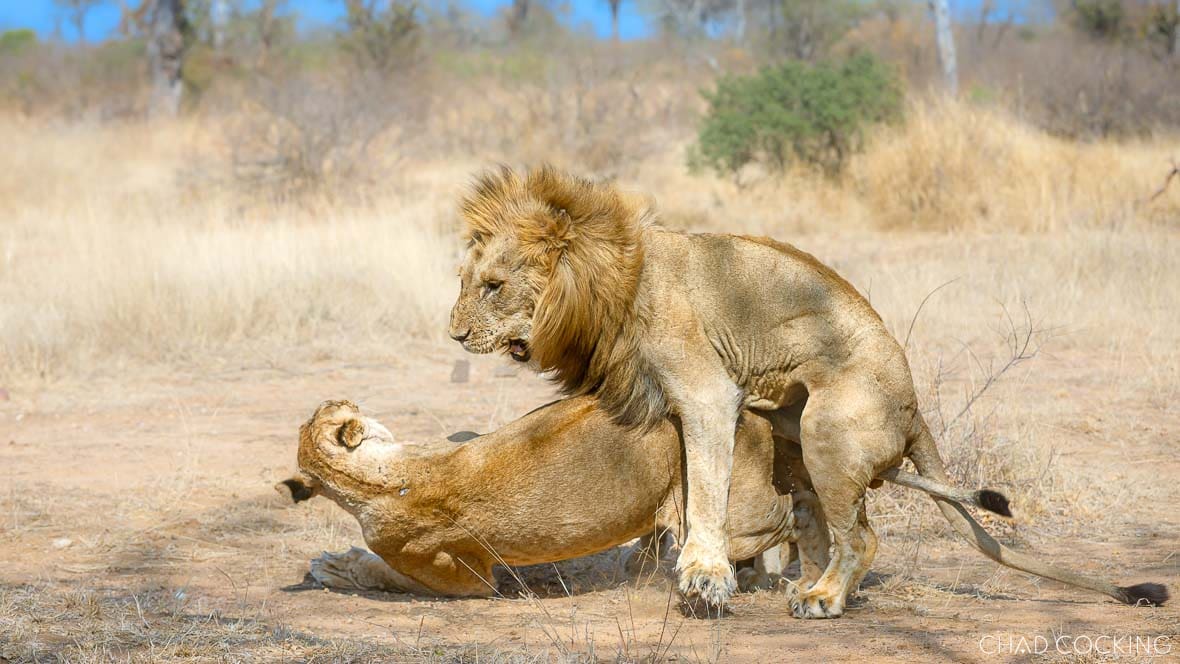
The Nkombo male and a Sark Breakaway lioness during mating — a pivotal moment marking a potential new alliance in the Timbavati.
Before we go and judge the lionesses for being so eager to mate, we also need to appreciate that such flirtatious behaviour is often used as a tool to pacify new males – give them what they want, and they will likely be less aggressive. It could also have been part of a diversion tactic from the lionesses, giving the other 13 members of the pride a chance to retreat to safer ground whilst the new males were distracted. Irrespective of the motive, it was a play that worked…for now.
Unsettled
With new males on the scene, the Sark Breakaways are feeling something that they have not felt for at least six years; unsettled.
In late July, after a week of ridiculous feasting (two buffalos and a wildebeest in five days), the 18 members of the Sark Breakaway Pride settled on Sunset Plains and roared the night away. Usually, these roars would chase off any opposition. But they lacked the baritone qualities only a big male lion can put out. This drew in the two Nkombo males, which sent the pride running south. It was then that tragedy struck, but not from the Nkombo males themselves. Instead, the Sark Breakaway Pride fled straight into two other nomadic lions from the south, and this interaction led to the death of two of the pride’s cubs.
After that day, the pride has been bouncing around to all corners of their territory. The days of being the absolute rulers of their kingdom are done. They now need to watch their backs, even in the core of their territory – an area that should be their safe place. The three lionesses that have the four dependent cubs and sub-adults have splintered from the main pride, and have been keeping a very low profile. The six young males have tried to stick with the other three lionesses, but this attachment will only lead to trouble down the road. Perhaps sensing what was coming, the two older Sark Breakaway males made a foray deep into the Greater Kruger when they were reported seen in Thornybush Game Reserve to our south-west – some 20km away. We all thought that this was it; at almost four years old, the males had finally left home and gone off to find their own pride. We didn’t even get to say goodbye.
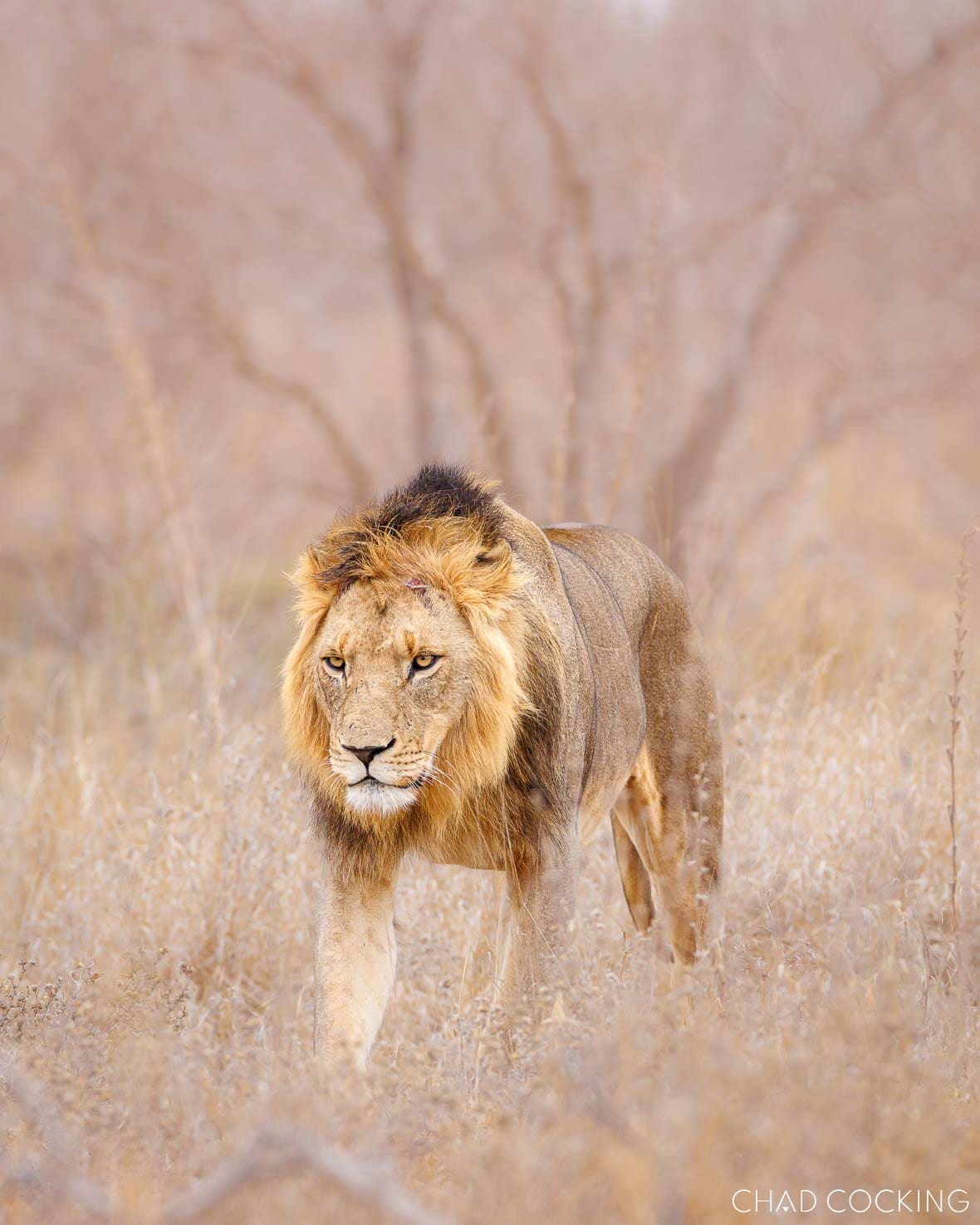
One of the older Sark Breakaway males strides through the dry grass, his mane catching the light of another day in the wild.
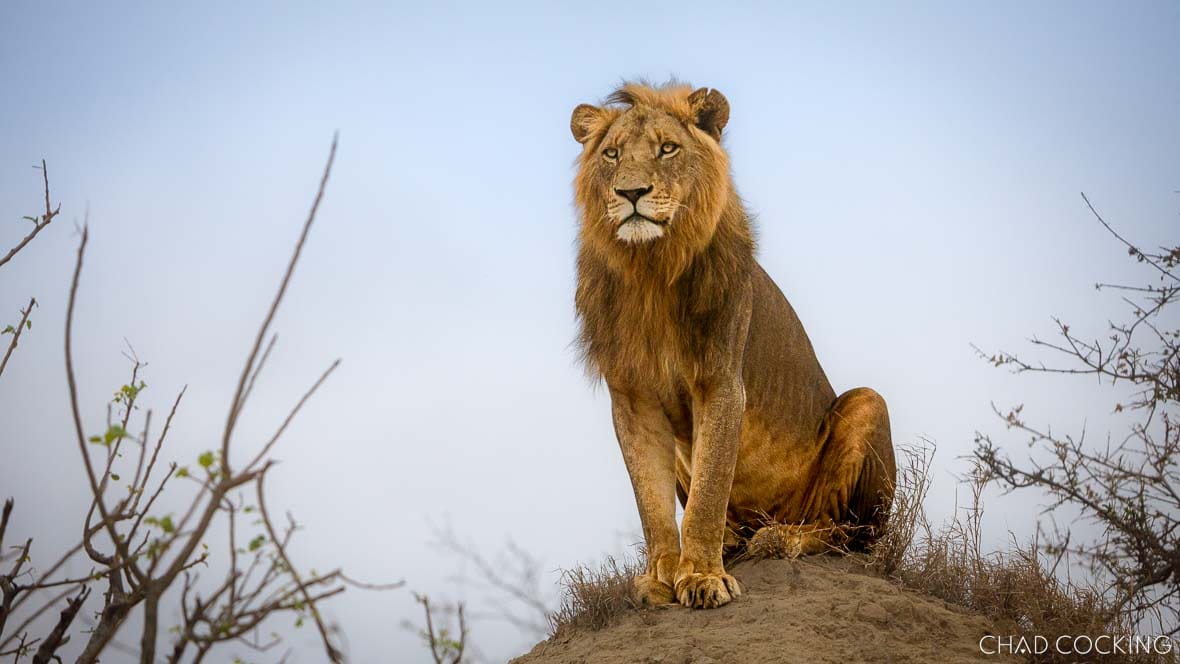
An older Sark Breakaway male surveys the Timbavati from his vantage point — calm, confident, and commanding in the soft morning light.

Map illustrating the 28 km movement of the young Sark Breakaway males as they shifted territories from Tanda Tula into Thornybush after the arrival of the Nkombo males.
As it turns out, we needn’t have worried, as within a couple of weeks they were back with the pride. And they didn’t seem to mind the roars of the Nkombo males. Just last week, we left the two Nkombo males roaring less than a mile from camp – 12 members of the Sark Breakaway Pride were no more than 3 miles to the north. We woke the next morning to roars coming from the same direction as the Nkombo males the night before. Following up, guides found that the roars were coming not from the two Nkombo males, but the six Sark Breakaway males! Were they simply roaring to locate the rest of the pride that got fragmented during the evening, or were they roaring for something more defiant? Is it possible that these males – particularly the two older ones – don’t want to give up on the easy life, and are making a stand against the Nkombo males? This seems rather unlikely, but it is nice to dream of the six of them forming another super coalition, and going on to dominate some area for years to come.
So what happens now for the Sark Breakaways?
Although these changes are no doubt going to shake things up for the lions of the Timbavati, change is sometimes good. Splinter prides, mating, new cubs – these are the positive things that follow pride take overs. It is the way lions work. There will be losers too; the young males won’t be welcomed, and unless they make an unlikely stand against the Nkombo males, all six Sark Breakaway males will have to move off and find a new home (as does every young male lion).
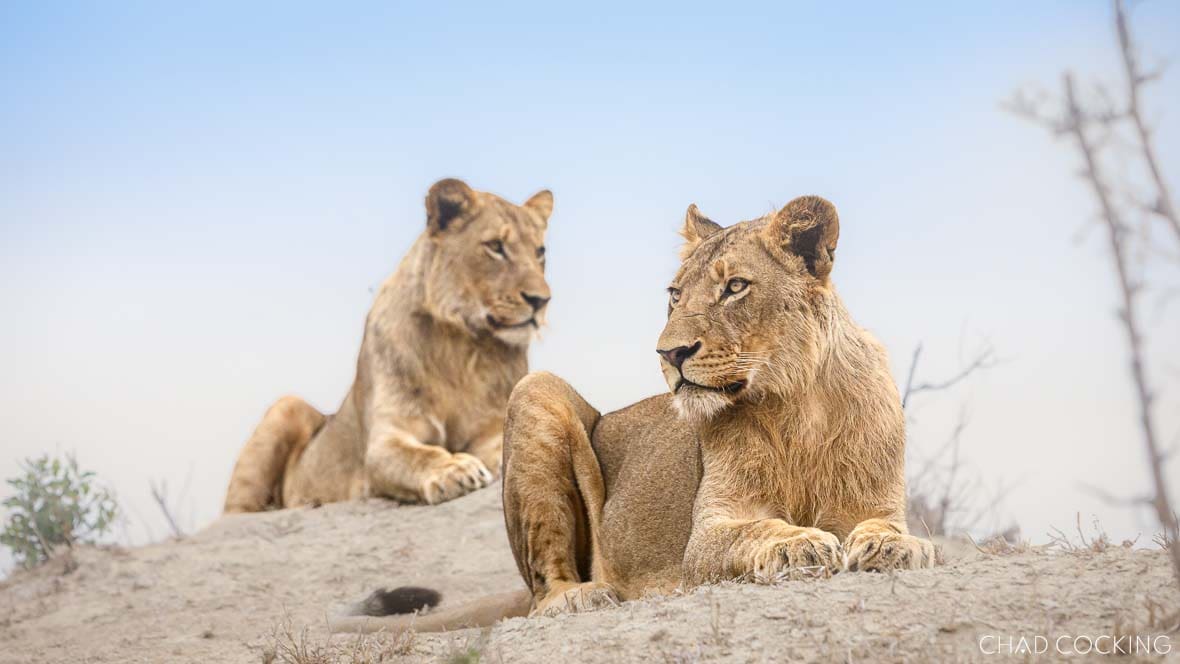
Two young Sark Breakaway males rest together on a sandy rise — a brief pause in their journey toward dominance.
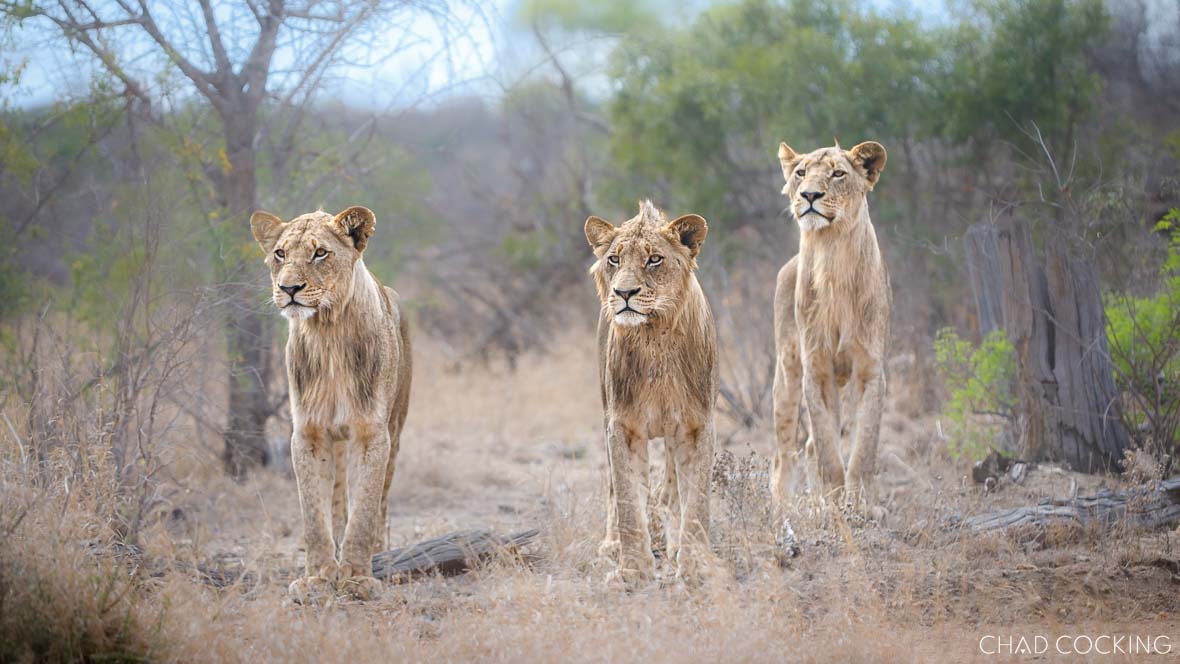
The young Sark males — growing in strength and confidence as they begin to explore the wild edges of their pride’s territory.
Of greater concern is how long the mothers of the sub-adult lions of the pride will deal with this potential pressure. Will they be able to find a space close enough to the Vuyela males to ensure that the Nkombo males don’t pursue them? Do they move out of the area until they find no pressure from other lions, creating another breakaway pride? Or will the Nkombo males be persistent and track down this portion of the pride. If this worst-case scenario unfolds and the males do find and dispatch of the youngsters, it would at least result in all six adult lionesses reuniting and forming a pride under the control of the Nkombo males, beginning the next chapter in their pride’s story. They have shown what good mothers they are, and they would no doubt successfully raise more cubs with the new males.
This pride definitely has the most uncertainty hanging over their heads, but what about the other prides?
The River Pride
This pride has had a tough twelve months. Losing a couple of youngsters; losing one of their three adult lionesses; and then the miraculous recovery of the oldest female who had looked like she was paralysed. Despite making a remarkable recovery, she is not in a physically fit enough condition to hunt. This left the entire future of the pride down to one lioness and her inexperienced youngsters. It has been a hard-fought success story, but I am tempted to say that the pride is through the hardest part. The three sub-adults are now over two years old, and are able to contribute positively towards the hunting success of the pride – and it shows. The pride is looking better now than they have for a long time. If they can keep this up for another six months, the three youngest lions will also be in a position to contribute to the pride, and they will be looking well set for the future.
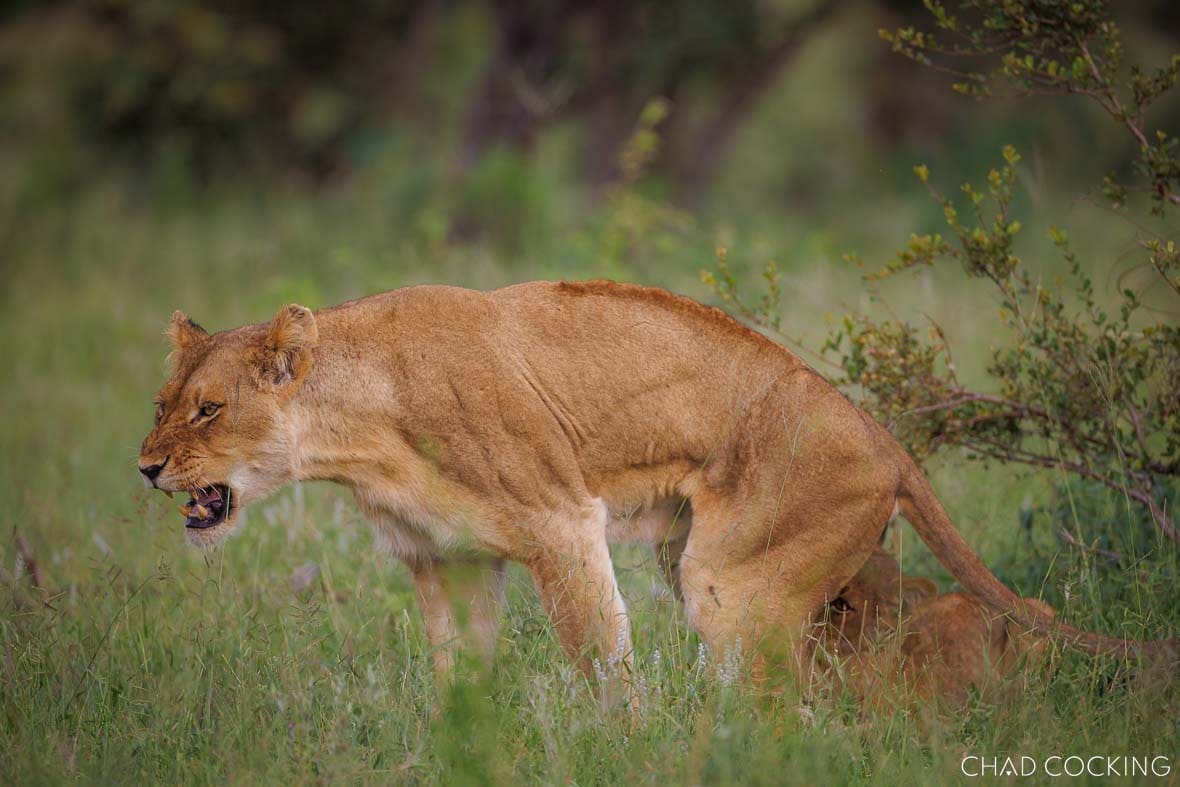
An injured River Pride female, battle-scarred yet unbroken, continues to fight for her place in the wilds of the Timbavati.

The young lions of the River Pride — the next generation on whose survival the pride’s future depends.
However, these six months hold some uncertainty too. While the Nkombo males have not yet pushed east into River Pride territory, it is a likely scenario. Although the Vuyela males do not move with the River Pride, they are still somewhat active in the general area, and this could be enough to keep the Nkombo males away from the River Pride. For now.
How Long Can They Remain Kings?
So much of the future dynamics of the lions of Tanda Tula depends upon how long the Vuyela males can hold on to their power. Largest in size, they were also once the largest in number. The good thing with big coalitions is that even if you lose one member, you remain strong.
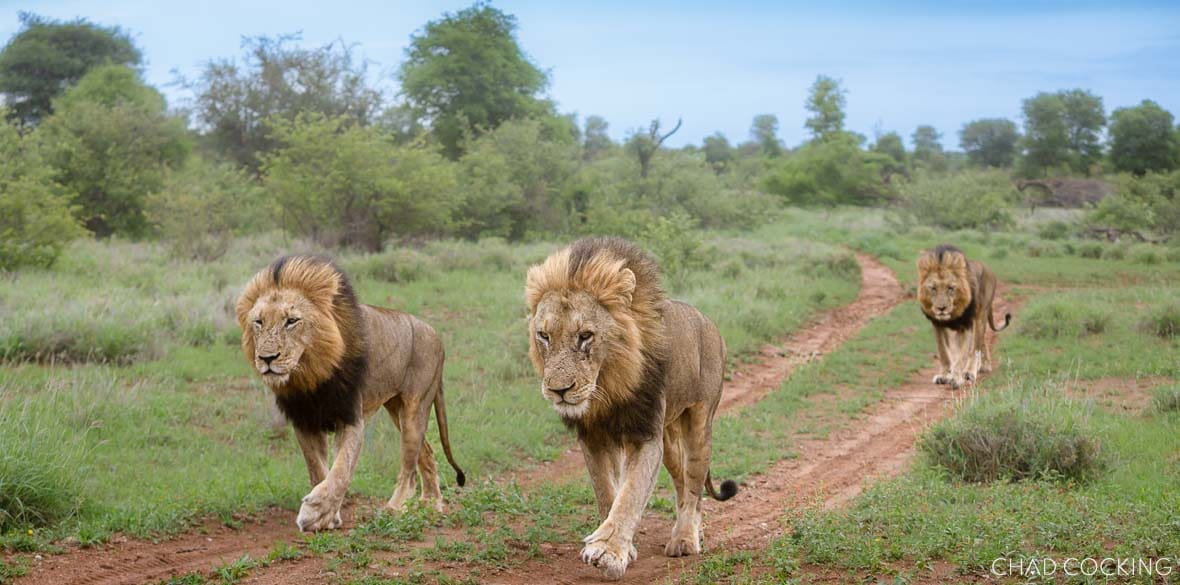
The Vuyela coalition in their prime — three dominant males moving in unison through the heart of the Timbavati.
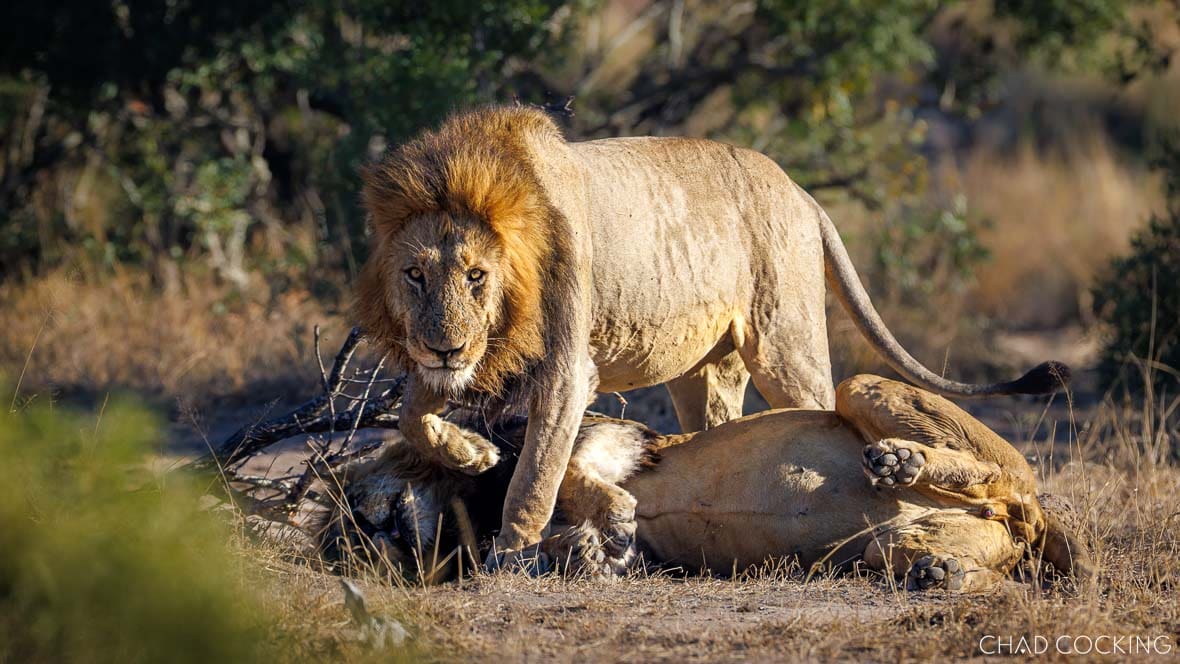
Months later, the Vuyela males remain inseparable — their bond still strong as ever, a testament to loyalty within the wild.
But what happens when you lose two members? Sadly, this is a reality facing the Vuyela males. In the past weeks, two of their coalition members were found dead, succumbing to illness. This severely weakens their power, but as lion dominance is still a numbers game, as long as the remaining three males can stay healthy, they should have enough clout to keep control over the Mayambula Pride – a pride whose future has been looking the rosiest of the lot.
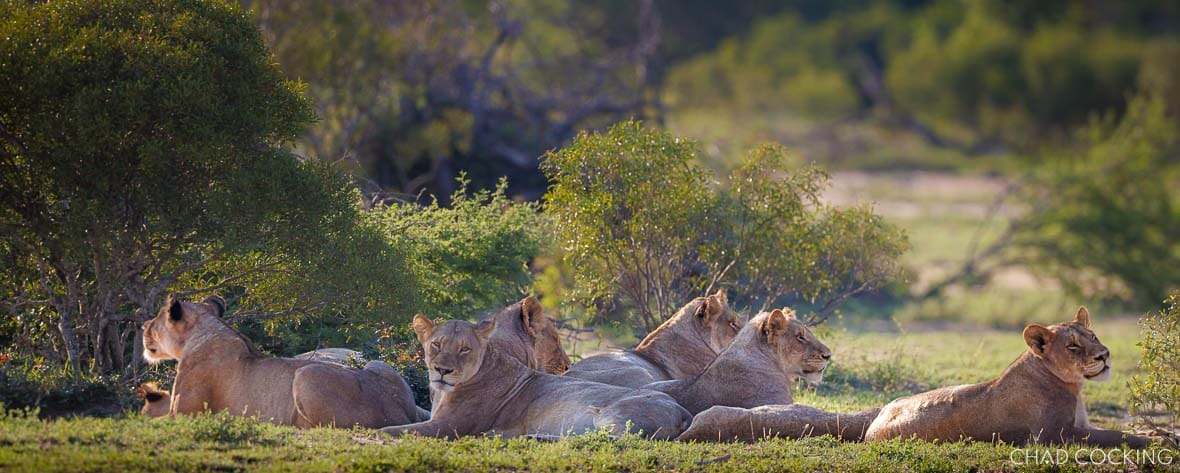
The Mayambula Pride rests in the shade — full of potential, but their future depends on the strength of the Vuyela males who protect them.
The pride, consisting of nine adult lionesses – two of which have had cubs already, with a couple more heavily pregnant – has great potential to grow into our next super-pride. If each of the females has even two cubs, we suddenly sit with a pride of 30 lions! The benefit they have over the others is that the Vuyela males are very attached to this pride at the moment, seldom leaving their territory. This will give them the protection they need to help raise these cubs to maturity. The last time the pride approached these numbers, they centred their activities in Tanda Tula’s eastern sections, and we are keeping fingers crossed that they once again follow suit this time around.
A Second Super Pride in The Making
The Mayambula Pride is not the only pride with potential; the Giraffe Pride is doing well in the west. Under the protection of five Birmingham Breakaway males (well, we believe all five are still alive – but like the Vuyela males, they seldom operate together), this pride sits in the same boat as the Mayambula Pride in the east; nine adult lionesses – some have had cubs, others are not far off from dropping more – and the safety net of a strong coalition of males. This pride, too, could grow to close to 30 lions over the coming year, exceeding the 25-strong members we enjoyed in 2022/23, and giving us the dream of having a second large pride roaming our traversing area.
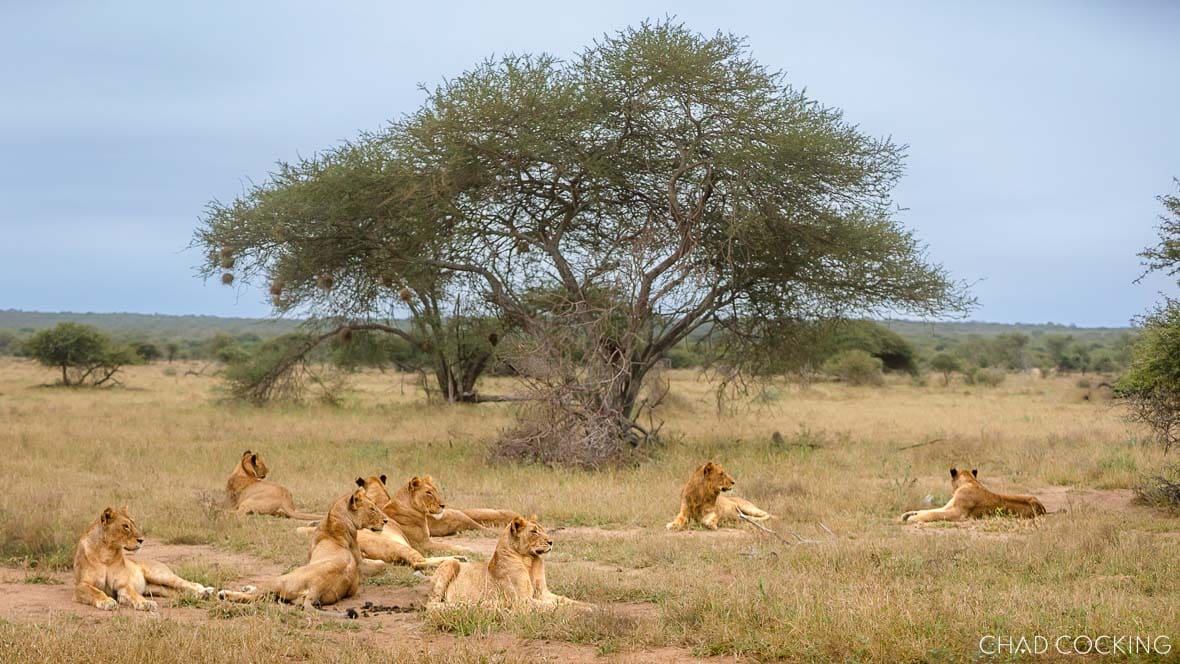
The Giraffe Pride rests peacefully in the shade, their stability ensured by the protection of the Birmingham Breakaway males.
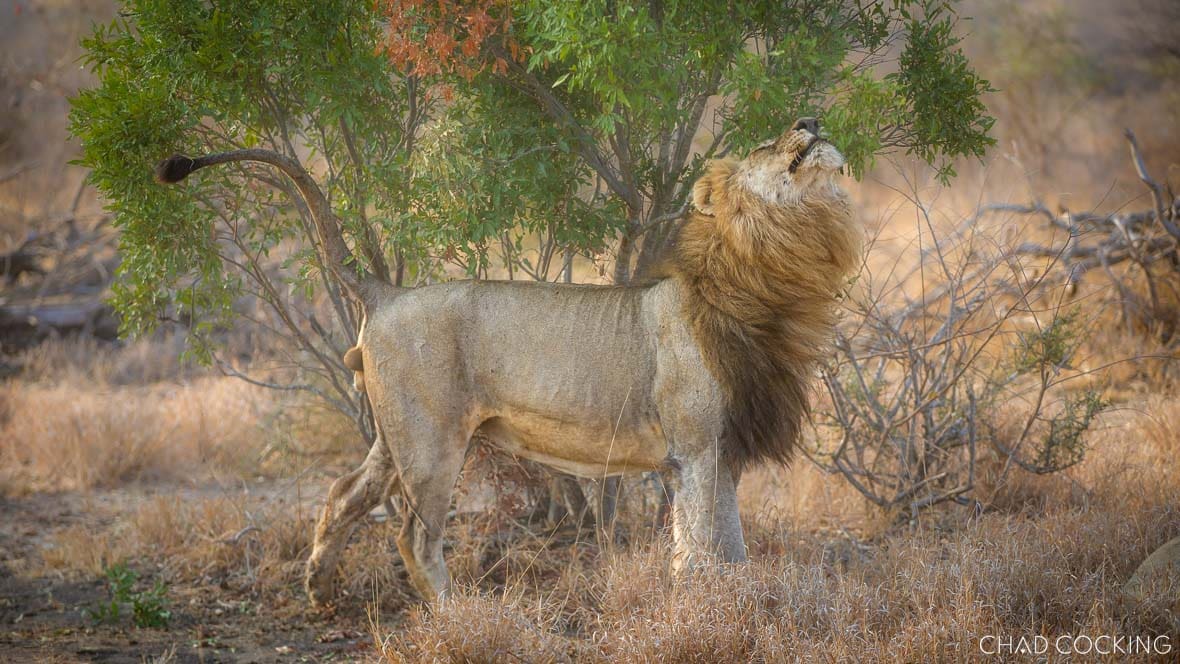
A Birmingham Breakaway male marks his territory — a powerful act that defines dominance and safeguards the Giraffe Pride’s future.
So, while our lion dynamics stand on the precipice of the largest shake-up we would have seen in a few years, there are good signs that some of our prides could make the push towards super-pride status, and that is something to look forward to!
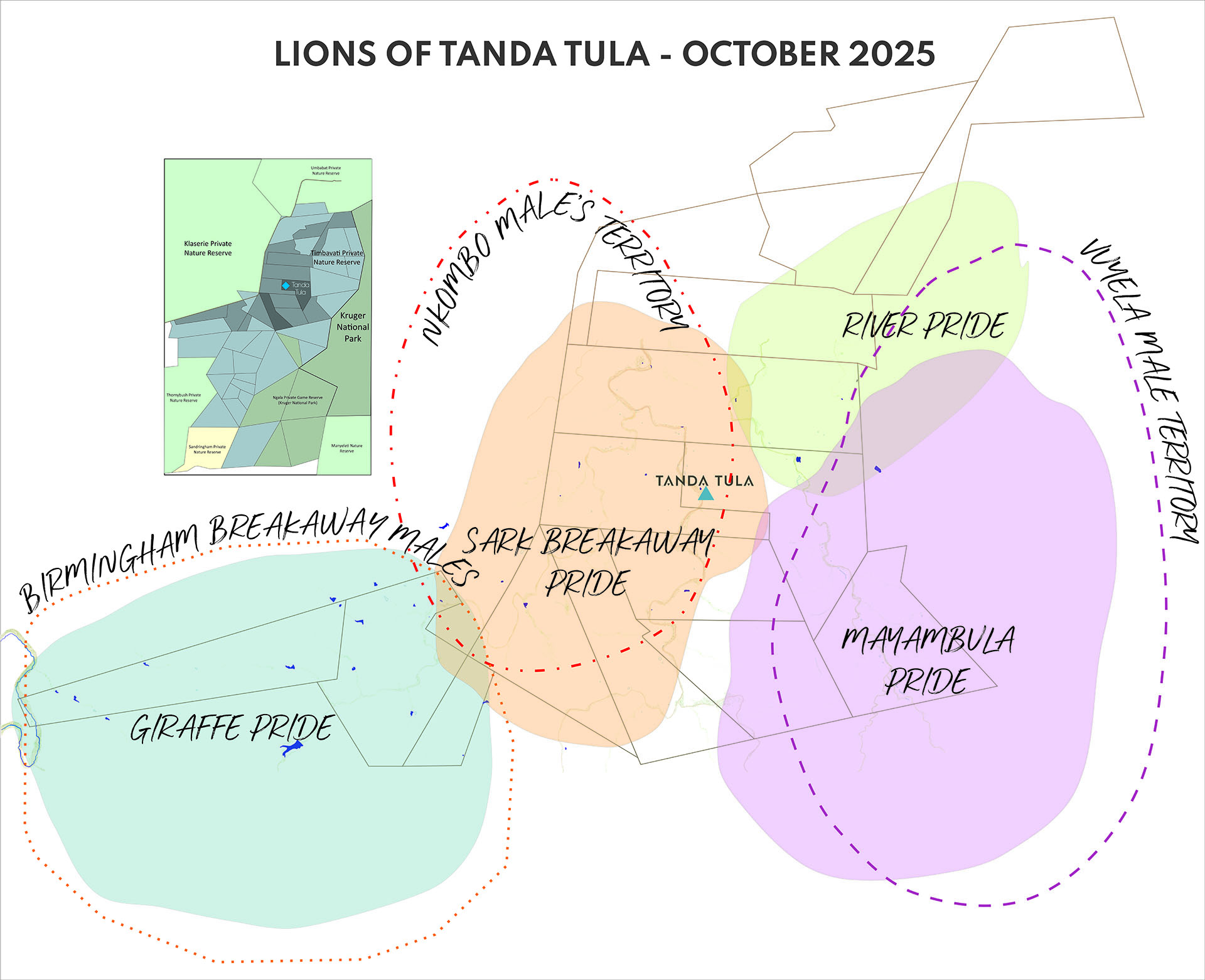
By October 2025, the territories around Tanda Tula had shifted — with the Nkombo males expanding westward, the Vuyela males holding firm in the east, and the Sark Breakaway Pride extending their range.
Let’s wait and see
Despite all that has been written here, the truth is that the future prognosis is pure speculation. Being part of an open system, we have no idea which lions could waltz into the Timbavati tonight, and throw a proverbial spanner in the works. I speak only of the two Nkombo males, but that unfairly writes off the two Mawondane males and their increasing size and confidence. Will they move off without a fight, or will they stand their ground in an area that has become their home over the past year and a bit?

One of the Mawondane males rests in the grass, his steady gaze hinting at both uncertainty and potential — what will the future hold for him?
And what about the northern Ncila males? These five males have settled with the Western Pride up in our northern traversing area, but they might “pull a Vuyela” and decide that one pride is not enough, and if that search for a new pride pushes them south, then everything I speculated will be as erroneous as my weekly lottery picks. Ultimately, what happens out there for the lions is a bit of a lottery; the big difference is, they have much more riding on their gambles.
Be sure to keep up to date with the happenings of the lions on our social media feeds, as well as future blog posts.
Until next time!




